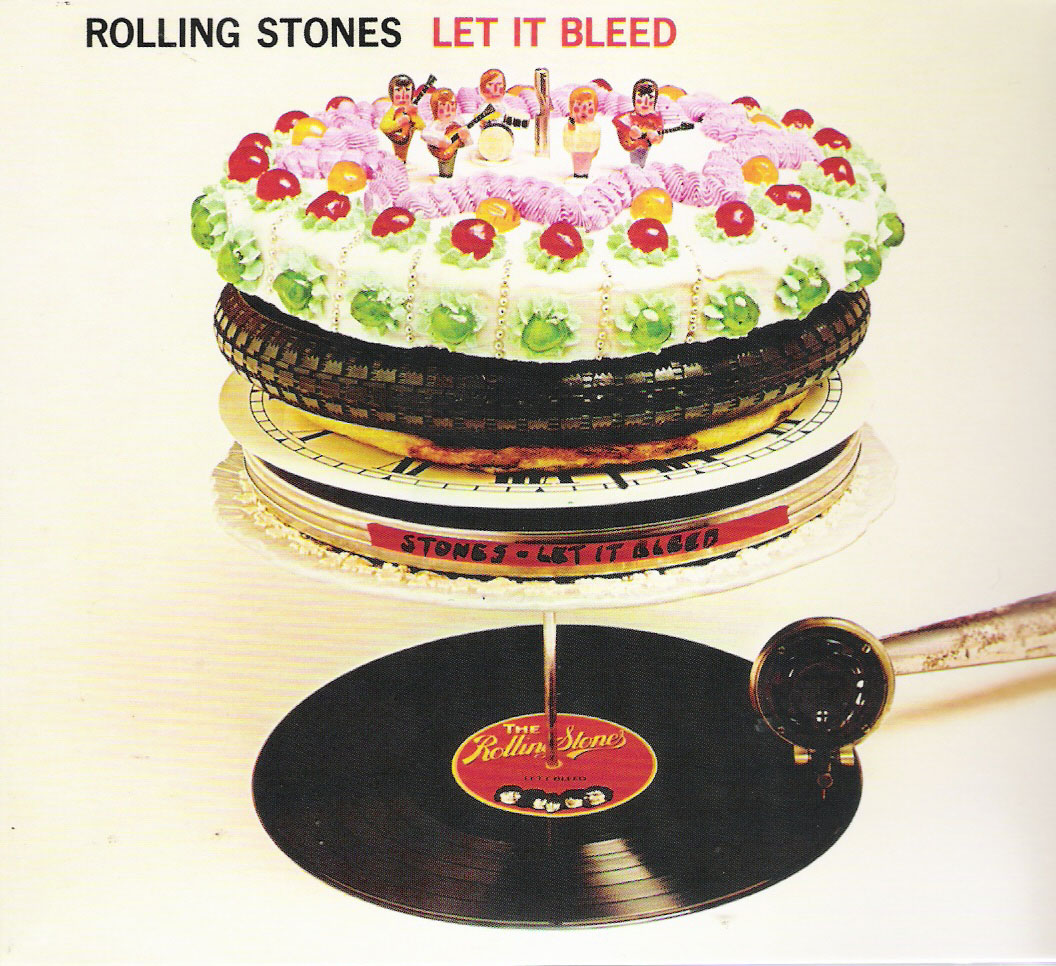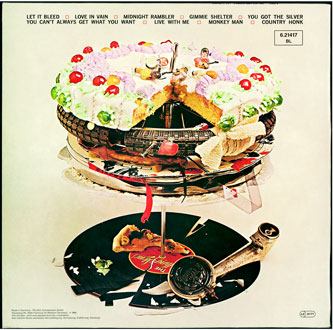
 BY ED KING ROCK EXPERT How deep should first musical impressions cut? Is there more in a track than may have first caught my ear? Do I clutch too tightly to the romantic notion that no record should ever sound different than how I first heard it, or more accurately the collective power of the record’s first 100 spins? It’s not like I listen to my childhood vinyl on the same record player I had as a kid, but I run up against such questions any time I pick up a reissue of a beloved album that’s been remastered or released in its original mono form, a German true stereo mix, or what have you. Like my friend who can’t get past any digital remastering of “Satisfaction” in which you can hear the acoustic guitar and piano, which were buried in the rhythm section on the vinyl versions of the song we grew up with, I tend to get a little attached to how records sounded when I first heard them.I recently downloaded a rare mono mix of The Rolling Stones’ Let It Bleed, my favorite post-Brian Jones Stones album and, from my years of spinning it on vinyl, the best-sounding Rolling Stones album. I’ve never been that much of a purist about mono vs stereo mixes; in fact, any purism I hold in this regard is centered around my personal experience. If I first heard an album in mono, then mono is the “correct” format, and vice versa. The mono mix of The Kinks Are the Village Green Preservation Society, which was included with stereo version on some CD reissue from a few years back, does not impress me. I continue to hold true to the magic of the flimsy, $2.99 Spanish vinyl pressing I fell in love with after bringing home from the Temple U. bookstore in the early 1980s.
BY ED KING ROCK EXPERT How deep should first musical impressions cut? Is there more in a track than may have first caught my ear? Do I clutch too tightly to the romantic notion that no record should ever sound different than how I first heard it, or more accurately the collective power of the record’s first 100 spins? It’s not like I listen to my childhood vinyl on the same record player I had as a kid, but I run up against such questions any time I pick up a reissue of a beloved album that’s been remastered or released in its original mono form, a German true stereo mix, or what have you. Like my friend who can’t get past any digital remastering of “Satisfaction” in which you can hear the acoustic guitar and piano, which were buried in the rhythm section on the vinyl versions of the song we grew up with, I tend to get a little attached to how records sounded when I first heard them.I recently downloaded a rare mono mix of The Rolling Stones’ Let It Bleed, my favorite post-Brian Jones Stones album and, from my years of spinning it on vinyl, the best-sounding Rolling Stones album. I’ve never been that much of a purist about mono vs stereo mixes; in fact, any purism I hold in this regard is centered around my personal experience. If I first heard an album in mono, then mono is the “correct” format, and vice versa. The mono mix of The Kinks Are the Village Green Preservation Society, which was included with stereo version on some CD reissue from a few years back, does not impress me. I continue to hold true to the magic of the flimsy, $2.99 Spanish vinyl pressing I fell in love with after bringing home from the Temple U. bookstore in the early 1980s.
There have been a few exceptions to my “feels like the first time” rule of thumb: there’s a German true stereo version of The Beatles’ Magical Mystery Tour that allows the mixes to breathe and provides sonic justification for some of the lesser songs, such as “Blue Jay Way” and “Fool on the Hill.” Similarly, for as much as I am known to bitch about hearing acoustic guitars and tambourines too clearly in remastered 1960s records, the remastered version of The Band’s self-titled album doesn’t miss a beat – or audible grain of wood and strand of facial hair – from the original vinyl version I rocked myself to sleep to as a 5-year-old boy.
Before researching the circumstances of this mono mix of Let It Bleed, I was more optimistic than I would have expected about playing this version. To me, the original album combines the best of both eras of The Rolling Stones, the concise, dance-oriented, slightly twisted pop structures of the Brian Jones-era singles with the grainy, darker vibe of an accomplished band itching to break free from the pimply, teen singles market. One cool thing about mono mixes is that they usually help gel the rhythm section on a recording, and at its peak the Stones’ rhythm section cannot gel too much!
To me, the original album combines the best of both eras of The Rolling Stones, the concise, dance-oriented, slightly twisted pop structures of the Brian Jones-era singles with the grainy, darker vibe of an accomplished band itching to break free from the pimply, teen singles market. One cool thing about mono mixes is that they usually help gel the rhythm section on a recording, and at its peak the Stones’ rhythm section cannot gel too much!
I found myself taking notes on the differences between my old vinyl edition (in stereo), my remastered digital stereo version that a friend burned me some time ago, and this mono mix. Days later, when I finally did a little research into the history of this mono mix, I went down a rabbit hole of disputed accounts of the validity of this mono mix. This version I downloaded is not an official release, and as is typically the case with any Stones recording the details are murky. Some “experts” claim this is a “needle drop” of a rare, dedicated mono mix, from the final days when record companies released new albums in mono as well as stereo, whereas other claim this is a “fold-down” of the stereo release, that is, someone essentially hit the “mono” button on their stereo and recorded that. Who knows? Regardless, there are differences in the listening experience that are worth dissecting if you’re a rock obsessive, like me. If you’ve heard this mono edition, maybe you have your own thoughts on the matter.
Gimme Shelter
Growing up with this song I was always pulled into this song by the overall vibrato/underwater rhythm from Keith’s guitar and the percussion, but the space around the drums and vocals in the stereo mixes I’ve always heard are what gave the song the power to be one of Martin Scorsese’s go-to soundtrack selections to cue a character’s turn toward the dark(er) side. The mono mix makes the drums sound smaller (if tighter) and, more damaging, narrows the space allotted to Mick and the back-up singers. The impact of Mick Taylor’s guitar fills is also reduced.
Love in Vain
I’m typically not a fan of da blooz, and I truly regret the Stones getting too far into this stuff in future releases, but I find the mono version preferable to the stereo version. If a rock band’s going to do olde tyme music like this, why not keep it simple and let the fine, relaxed playing shine through?
Country Honk
I’ve always dug this take on “Honky Tonk Women” and find the simplicity of the mono mix preferable for the same reasons as stated for “Love in  Vain.” The kick drum drives the mono mix in a more satisfying way, and the snare is nicely buried in the rhythm bed. The acoustic rhythm guitar sounds nice an cheap in mono, as if the strings haven’t been changed in 2 years. Somehow, in mono, the folksy Stones songs from this album sound more like the folksy songs Led Zeppelin recorded for Led Zeppelin III – using the Stones’ mobile recording studio, no less!
Vain.” The kick drum drives the mono mix in a more satisfying way, and the snare is nicely buried in the rhythm bed. The acoustic rhythm guitar sounds nice an cheap in mono, as if the strings haven’t been changed in 2 years. Somehow, in mono, the folksy Stones songs from this album sound more like the folksy songs Led Zeppelin recorded for Led Zeppelin III – using the Stones’ mobile recording studio, no less!
Live With Me
For me, this is the transitional Stones song that best combines what I love about snarling singles like “Satisfaction” and “Get Off My Cloud” and the band’s late-’60s growth as musicians. One of my favorite 4-on-the-floor Stones stomps can’t lose in mono! It’s all driving beat and bass. Mick’s vocals don’t need to have “space.” The piano and horns are flattened out in the mono mix to support the song’s kick-ass objectives. There’s still nothing wrong with the stereo mixes I’ve lived with for the past 35 years, but hearing this in mono – whether “true” mono or not – is a lot of fun.
Let It Bleed
It’s hard for the title track to go wrong. The Led Zep III directness of the mono version fits the vibe of the song. Lacking the space of the stereo mix, Jagger’s vocals sound more powerful and less affected. Mick Taylor’s slide fills are warm and powerful. On the other hand, this is one song where I miss getting a better feel for Charlie Watts’ drumming. In stereo I can imagine every tic in Charlie’s style; in mono Charlie’s quirks are smoothed out.
Midnight Rambler
The bass tones from the rhythm guitar are out of this world on the mono version! I can get off on the rhythm guitar alone. It’s weird not hearing the dynamics of the stereo mix, though, including the intricacies of the guitar interplay and Charlie’s drums. The clarity of those elements in stereo add to the sense of foreboding, doom, and terror that’s at the heart of the song’s story. On the other hand, I’m not a slasher movie fan. There’s something to be said for the more-direct, less-mysterious mono mix, which sounds a bit like Mick Jagger fronting The Yardbirds.
You Got the Silver
This classic “I wish Keith would sing lead more often” numbers also falls into the simple joys of mono category of the album’s other folksy tunes.  The band’s entire exercise in acoustic country-blues and folk sound way less precious in mono. I wish they’d have cut all those songs I don’t like on Exile on Main Street in mono, without all the studio voodoo. Speaking of studio voodoo, the “whooshing” slide guitar noises that fade in an out of the song are not as cool in mono, but since I’ve never felt the Stones made much use of studio trickery and since I no longer get high and experience that unexpected buzz from the song’s effect, it’s cool.
The band’s entire exercise in acoustic country-blues and folk sound way less precious in mono. I wish they’d have cut all those songs I don’t like on Exile on Main Street in mono, without all the studio voodoo. Speaking of studio voodoo, the “whooshing” slide guitar noises that fade in an out of the song are not as cool in mono, but since I’ve never felt the Stones made much use of studio trickery and since I no longer get high and experience that unexpected buzz from the song’s effect, it’s cool.
Monkey Man
There’s a lot I like about this song, but to me it’s always been a poor man’s combination of “Gimme Shelter” and “Live With Me.” The mono version does no more or less to dispel this notion. The added dynamics of the stereo mix are both a good and a bad thing: good in that they provide ear candy and bad in that the added ear candy underlines how cobbled together the song is. I’ll tell you one thing that’s really cool about the mono version that I never noticed on the stereo mix before: there’s a little backing vocal that comes in on the last line of the chorus that’s more than a double-tracked vocal by Jagger, which is how I always heard it in stereo. As Jagger pauses on the “glad you are a monkey woman too” line and “monkey woman too” backing vocal line is more distinct than I’ve ever heard it in stereo. Like.
You Can’t Always Get What You Want
Like “Gimme Shelter,” this top-shelf song from Let It Bleed is worthy of producer Jimmy Miller’s full stereo recording. Most worthy, perhaps, is Miller’s drumming on the song, or at least the song’s fadeout, if stories of him having to take over for a stiff Charlie Watts are to be believed. It is cool, in the mono mix, to be able to better follow the little rhythms of the acoustic guitar. I could see this version coming in handy for any in a Stones cover band.
Bonus Tracks
I guess even a bootleg mono edition needs to have some bonus tracks, and this one packs some goodies. There’s a version of “Gimme Shelter” with  Keith one lead vocals and an alternate version of “Honky Tonk Women” with a different lead vocal by Mick and some alternate lyrics. There’s a version of Exile’s “Loving Cup,” which I never listen to enough on the real album to be able to tell you anything about in this version. Mick Jagger sings lead on “You Got the Silver,” which isn’t bad but only makes me think it would be cool if Keith sang lead a little more often. “Sister Morphine” is part of the bonus tracks. I’ve never understood this song’s appeal in any version, not even with the image of a young, buxom Marianne Faithfull in mind. There’s a version of “Memo From Turner” that makes me glad the Stones and Mick solo recorded two more, better versions for commercial release. Finally there’s an honest-to-goodness commercial release, the mono 45 mix of “Honky Tonk Women,” which is a song that is hard to ruin in any format. Even the modern-day Stones still manage to pull this one off.
Keith one lead vocals and an alternate version of “Honky Tonk Women” with a different lead vocal by Mick and some alternate lyrics. There’s a version of Exile’s “Loving Cup,” which I never listen to enough on the real album to be able to tell you anything about in this version. Mick Jagger sings lead on “You Got the Silver,” which isn’t bad but only makes me think it would be cool if Keith sang lead a little more often. “Sister Morphine” is part of the bonus tracks. I’ve never understood this song’s appeal in any version, not even with the image of a young, buxom Marianne Faithfull in mind. There’s a version of “Memo From Turner” that makes me glad the Stones and Mick solo recorded two more, better versions for commercial release. Finally there’s an honest-to-goodness commercial release, the mono 45 mix of “Honky Tonk Women,” which is a song that is hard to ruin in any format. Even the modern-day Stones still manage to pull this one off.
I recommend downloading a copy of this mono mix, if you can find it, or hitting the mono button on your stereo the next time you spin your stereo lp. I found listening to this album in mono way more interesting than I would have expected. I’m now curious to hear other late-’60s albums, during rock’s transition from a mono singles market to a stereo album market, in this way.
